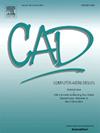B-spline curve interpolation to ordered points through shape quality optimization
IF 3.1
3区 计算机科学
Q2 COMPUTER SCIENCE, SOFTWARE ENGINEERING
引用次数: 0
Abstract
B-spline curve interpolation to sequential data points is a fundamental problem in various applications and has been extensively studied. However, little attention has been given to optimizing the shape quality of the interpolation curve for each specific dataset. In this paper, we propose a novel approach to B-spline curve interpolation that directly enhances shape quality by minimizing a curve-quality evaluation function, jointly optimizing the control points, location parameters, and knot vectors. The key challenge lies in satisfying the necessary constraints to ensure the existence of a B-spline interpolation curve. To address this, we reformulate the problem as an unconstrained optimization, which inherently enforces these constraints. The interpolation curve is derived by perturbing an approximation curve to eliminate its distance error while preserving its optimized shape quality. To theoretically justify this process, we establish a formal connection between the approximation and interpolation curves, proving that the distance error between them is bounded by a factor of the approximation error with respect to the data points. Experimental results and comparisons with existing methods demonstrate the effectiveness and robustness of our approach in producing high-quality interpolation curves.
通过形状质量优化实现b样条曲线对有序点的插值
b样条曲线对序列数据点的插值是各种应用中的一个基本问题,已经得到了广泛的研究。然而,针对每个特定数据集优化插值曲线形状质量的研究却很少。在本文中,我们提出了一种新的b样条曲线插值方法,通过最小化曲线质量评价函数,共同优化控制点、位置参数和结向量,直接提高形状质量。关键的挑战在于满足必要的约束以保证b样条插值曲线的存在性。为了解决这个问题,我们将问题重新表述为无约束优化,它本质上强制执行这些约束。通过对近似曲线进行扰动,消除其距离误差,同时保持其优化形状质量,从而得到插值曲线。为了从理论上证明这一过程,我们在近似曲线和插值曲线之间建立了正式的联系,证明它们之间的距离误差是由近似误差相对于数据点的一个因子所限制的。实验结果和与现有方法的比较表明了该方法在生成高质量插值曲线方面的有效性和鲁棒性。
本文章由计算机程序翻译,如有差异,请以英文原文为准。
求助全文
约1分钟内获得全文
求助全文
来源期刊

Computer-Aided Design
工程技术-计算机:软件工程
CiteScore
5.50
自引率
4.70%
发文量
117
审稿时长
4.2 months
期刊介绍:
Computer-Aided Design is a leading international journal that provides academia and industry with key papers on research and developments in the application of computers to design.
Computer-Aided Design invites papers reporting new research, as well as novel or particularly significant applications, within a wide range of topics, spanning all stages of design process from concept creation to manufacture and beyond.
 求助内容:
求助内容: 应助结果提醒方式:
应助结果提醒方式:


